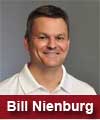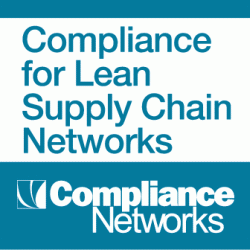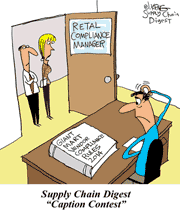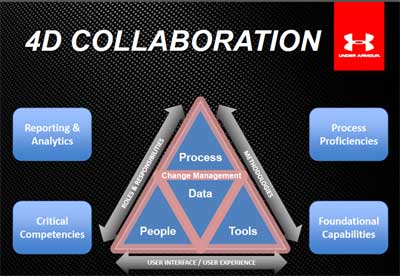 |
April 3, 2014 - Supply Chain Flagship Newsletter |
 |
| THIS WEEK'S SPONSOR: COMPLIANCE NETWORKS |
 |
|
 |
|
||||||||||||||||||||||||||||||||||||||||||||||||||||||||||||||||||||||||||||||||||||||||
Under Armour's Athletic Supply Chain
|
|||||||||||||||||||||||||||||||||||||||||||||||||||||||||||||||||||||||||||||||||||||||||
| GILMORE SAYS: |
"I love that - it simply says "We are playing to win." There is a level of supply chain energy and ambition here that is not common." WHAT DO YOU SAY? |
Under Armour the company is of course quite a story, and its rapid growth continues. It hit $2.3 billion in sales in 2013, and expects to grow another 22% in 2014, on its way to being a $4 billion company in 2016 and $10 billion by 2020. Since it went public in 2005, it has had a cumulative annual growth rate of 31%. That's a lot of sneakers and work out gear for sure.
Nienburg came to UA from Sara Lee and before that Procter & Gamble, by way of Georgia Tech. He said that early on at the company, he had a meeting with his team, and told them "supply chain collaboration was going to be a core competence" at Under Armour, referring to both internal and external collaboration - and let me tell you that objective is very real.
As basic as that goal sounds, I don't believe I have ever heard anyone say they were going to make collaboration a core supply chain competence. At many companies, it's more like a core incompetence, right? Where does your company stand on the collaboration excellence scale? More on this below.
Under Armour the company was built on the idea of speed in terms of its products and now its growth, and it has built a supply chain to match that velocity. You simply can't have a high-velocity product and growth strategy without the supply chain operating at the same clockspeed.
The company is obsesses in a good way on making fast decisions. "Speed is the order of the day," Nienburg said. And that recognizes that along the way, some of those decisions will be wrong.
"We want to make fast mistakes," he said.
The formula for growth at Under Armour - and maybe most everywhere - is growth equals speed x innovation, Nienburg said.
But he took that a step further. The job of the supply chain at UA is to deliver to the model below. I am not sure it stands up to mathematical rigor, but it makes wonderful common sense nonetheless:
(Speed + control + predictability) x innovation = successful growth
 The key point and challenge is how you combine speed with control and predictability. Can you achieve all three? Few do today, I would argue. Again, I have not heard anyone state the mission quite like this before. I don't have any magical approach for getting to that place, but it is clear Under Armour has this as a defining mission, and something they are aggressively combining people, process and technology to achieve.
The key point and challenge is how you combine speed with control and predictability. Can you achieve all three? Few do today, I would argue. Again, I have not heard anyone state the mission quite like this before. I don't have any magical approach for getting to that place, but it is clear Under Armour has this as a defining mission, and something they are aggressively combining people, process and technology to achieve.
Part of that is a detailed, integrated planning process, made more challenging (as for all apparel companies) by the notion of seasons: Spring/summer and Fall/winter. I don't have room for details here, but Under Armour is planning five such seasons at some level at any given time, obviously with increasingly levels of granularity the nearer-in a season is.
Nienburg used the analogy of jets landing on an aircraft carrier to explain these multiple planning horizons. The current season is a plane approaching the runway - it is double checking to ensure nothing has changed with the existing plan prior to its landing, and then focusing on execution of the landing and monitoring feedback loops. But behind that plane is another that will land in a few more minutes. That's the following season. Others are entering the air space, etc. - but all five planes are being planned and tracked simultaneously.
Ok, so back to collaboration. Nienburg said he was going to give the audience something of real value to take back, and he did. It is Under Armour's collaboration model, which Nienburg called "4D Collaboration," as shown in the graphic below.
Here is what is different about this model - it puts "data" at its center. Neither internal nor external collaboration will work without accurate, timely and granular data, Nienburg said. So that is where UA started its collaboration efforts, by investing in the data (master data management, data governance, etc., along with tools to leverage the data) that its sees as the foundation of collaboration competence and excellence.
When the barriers to effective collaboration are mentioned, the discussion usually starts with things like "trust" and "benefits sharing" and "processes" - maybe all of those and more are in the end largely symptoms of a lack of data.
The other elements in the model are basically people, processes and technology (tools), but I think Nienburg added some excellent additional insight to those common elements.
As just one example, UA has defined the critical competencies its people must possess to execute the level of collaboration and supply chain excellence it wants to achieve (moving targets, by the way, as it progresses down various maturity models). It then builds skills development and training programs to ensure its staff has those critical competencies.
Nienburg reports to chief supply chain officer James Hardy, by the way - I am sure he deserves much of the credit for all of this too.
The executive team is fully on board with this supply chain strategy. Nienburg said that in the last seven quarterly earnings calls the company has held, the supply chain planning system (Logility) that Under Armour has deployed as the technology foundation for its supply chain excellence has been referenced as a key component of the company's strong results.
Nienburg cited a number of goals Under Armour had for its supply chain, but I especially liked this one: "We will outperform our competitive set for quality; speed to market; reliable, compliant supply; flexibility; and cost competitive products."
I love that - it simply says "We are playing to win." There is a level of supply chain energy and ambition here that is not common.
To an extent, UA is the US version of Europe's Zara.
This all said to me it's time for more companies to get into supply chain game shape at the highest levels of the sport.
What do you think of Under Armour's supply chain thinking? Should more companies make supply chain collaboration a core competence? Let us know your thoughts at the Feedback section below.
| View Web/Printable Version of this Page |
|
|
|
YOUR FEEDBACK
As usual, received a number of short but positive comments from our Day 1 and Day 2 video review and comment from the MODEX show last week in Atlanta. Just providing a selection of a few of them below.
Feedback on SCDigest MODEX 2014 Coverage:
Once again, you did a great job of reviewing the Modex Show! It makes me feel like I was there. Good stuff and thank you. Richard J. Sherman, president & CEO Gold & Domas Research
|
||
Fantastic coverage. I do not know how you guys put these together so fast. I was not able to attend this year, and these videos really go along way to making up for that. Eric Dupree Des Plains, IL
|
||
Outstanding data summary on Walmart and Amazon.
Thank you for putting this together. Very insightful. Keep up the great work. Roger Jones St. Louis |
||
I read with interest the comments on the Bell and Howell linerless printer applicator. Linerless printer applicators have been available for many years (ID Technology manufactures one) but there are reasons that it has not been widely adopted.
1) By virtue of the linerless label technology, the label cannot be too sticky or it will stick to itself and or not make it through the engine and rollers without adhering causing a mess and downtime. The name of the game is sticking the label on the product and linerless is at odds with the ultimate objective. 2) Production and DC lines are getting faster and faster therefore our customers are increasingly demanding High Tac labels as the initial tack of the labels becomes more crucial with the increased conveyor speeds. Linerless labels have a poor initial tack. 3) Another wear item and variable is introduced into the linerless system, a cutter. This cutter wears and must be replaced and it needs to be routinely cleaned. 4) Linerless labels are not high volume in the industry therefore they are not cost competitive relative to die cut labels. Alan Shipman |
||
| Some great observations relative to MODEX! One area you neglected to mention is the fantastic addition of the "Supply Chain & Transportation" group! There is no question in my mind that this group enhanced the value of this show as it will also continue to grown in the future. Aristides (Ari) P. Smith, President & CEO Next Generation Logistics |
||
You and Cliff get better every year! I really look forward to these video summaries. Paul Cesario |
SUPPLY CHAIN TRIVIA ANSWER
Q: What term was apparently first used during a presentation at Procter & Gamble in 1999 by Kevin Ashton of MIT?
A: "The Internet of Things" – the title of the presentation Ashton made. Ashton was a co-founder of the Auto Labs at MIT.
| © SupplyChainDigest™ 2003-2013. All Rights Reserved. SupplyChainDigest PO Box 714 Springboro, Ohio 45066 |
POWERED BY: XDIMENSION
|











